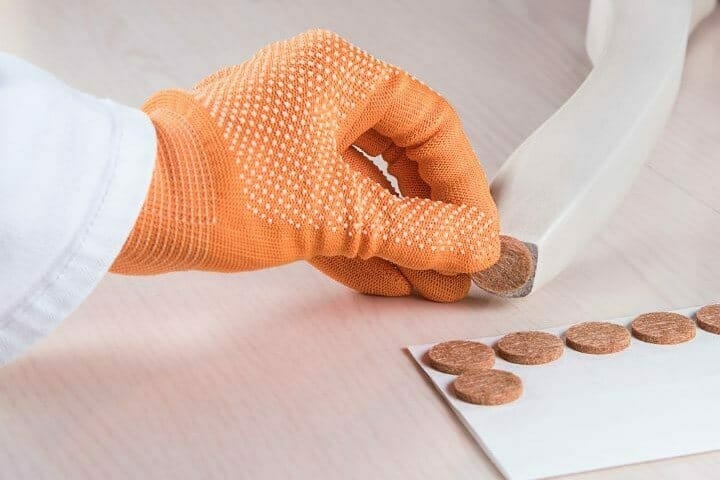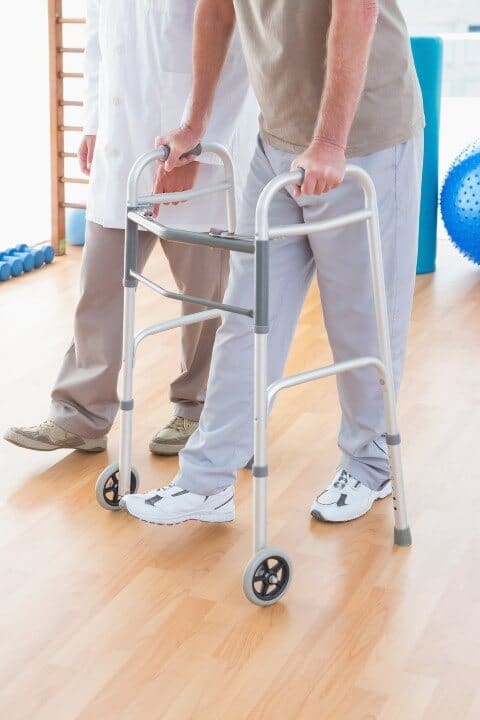Using a walker can help with your mobility and help keep you independent around your home, but when you’re dragging it across the floors a walker can cause damage to your home.
While you don’t want to give up using the walker, so that you stay safe and keep mobile, you also want to protect the floors of your home so they don’t get scratched or ruined due to assistive devices.
If you’re looking for ways to protect your floors from using a walker around your home, there are a few ways to do this. The good news is you can either protect from the bottom of the walker or you can do a few things to your floors to help protect them – or even both if you really want to.
Contents
Adding to the Walker
Tennis Balls
This is a very common option added to walkers, and it’s not very expensive to do either. With a standard walker, that doesn’t have any wheels, the four feet can drag against floor – especially if you are unable to fully lift it up off the floor. This easily cause scratches with the dirt and debris that gathers on the bottom of the feet.
There are sets of tennis balls that can be purchased specifically for this, with the holes already cut in them. They will easily slip onto the bottom of each of the feet of your walker and will be secured on there so that your walker can just glide across hardwood floors.
You may need to purchase small caps to go into the bottom feet of your walker to close off the bottom so that moisture doesn’t get in there.
The tennis balls will absorb moisture – even if you only use it inside, when something spills or shoes bring water into the house – and that water can cause premature rusting for your walker. Putting these caps on the bottom of your walker can help prevent this rusting, and protect your walker.
Foot Pads
In the same way you put pads on the bottom of furniture to prevent scratch marks when a chair or couch is accidentally moved, you can put footpads on the bottom of each of the feet of your walker.
There is some downside to using this method, though. They are sticky so you will need to make sure you apply them to the bottom of the walker in the place you want them to be. They also may collect dust and pet hair around the bottom, so you might need to be diligent in keeping them tidy and free of debris.
Additionally, some of the pads can become loose and move around so it can create a balance issue if they aren’t centered on the feet of your walker.
You may also like Best Upright Walkers for Seniors
Walker Glides
These function similar to the tennis balls on a walker, and help the unit move much more smoothly across the floor. Using these means you don’t necessarily have to life the walker up completely every time you move it.
Plastic glides are a little different from tennis balls, though, in that they don’t pick up bacteria as you’re moving the walker along the floor. This makes them antimicrobial and could be a better option for those who have allergies or who are sensitive to dust and dirt.
Walker glides are very easy to install on your walker, as well. They press into the bottom of the walker and secure in place. They’re designed so that almost anyone can insert them into the walker and remove them to change them out if they become damaged or wrecked.
With this information in mind, you might be asking if the tennis balls or glides are better. And that answer is simple: whatever you prefer is the better option. Each assistive device will have unique benefits and you may have to try both to find out which one you like.
Walker Glide Covers
As mentioned, you can add the gliders to your walker to help it move more smoothly along the floor and prevent scratches. In addition to that, if you want to be especially sure you won’t scratch your floors, you can add walker glide covers that are like slippers for the glides.
These glide covers can be washed regularly, too, as they are often made of a fabric similar to clothes. This can be helpful if you need to take your walker outside and they could get dirty.
Walker Socks
Have you ever heard of chair socks? Some people make them themselves, either knitted or crocheted, but you can also purchase them. They look like a small tube, with one end closed off and the other is open. You slide them on the legs of chairs, usually, to prevent scratching against floors.
In the same way these socks can prevent chairs from scratching, they can also be used for the legs of walkers to prevent them from ruining hardwood floors. They can be especially helpful if the walker isn’t being fully lifted when the person using it is walking, as if it’s dragged across the floor then there’s a higher chance of marks.
You may also like Walker, Crutches, or Cane After Hip Replacement – What to Use?
Felt Strips
This option is very similar to furniture pads, but you can usually cut felt strips to the right size needed. Furniture pads often come in pre-cut sizes so you may not be able to find the right size for you. The idea is that they stick to the bottom of the feet of the walker and will be soft against the floor to prevent scratching.
Feet Caps
These are plastic devices that slide into the bottom of each leg of a walker, and they usually have a soft bottom on them. They are also usually a little wider than the standard feet of a walker and can help with balance and using the walker.
You can purchase these in sets of two or four, depending on what kind of walker you have. They can also be removed, if needed, for cleaning or if the walker you’re using is a rental and you need to return it.
Protecting the Floors
The other option you may want to look at updating a few things around your home to protect your hardwood floors.
Area Rugs
Most people who have hardwood floors have some kind of area rug already to help protect their flooring from the dirt and debris that can be trekked in from outside.
Area rugs can definitely help keep hardwood floors protected, and looking like new in high traffic areas. They can easily be purchased for fairly reasonable prices, which means that you can add them to almost any room you want.
There are a couple downsides to them, though. Often times there will be exposed hardwood between the areas that the rugs cover so you can risk scratching or damaging that area.
On top of that, for those who use a walker area rugs can pose a tripping hazard. This happens because those who cannot completely lift the walker when walking might catch the corner of the area rug when moving and then trip because the walker can’t move forward.
You may also have concerns about the area run moving or slipping – and that can definitely happen on hardwood floors. To avoid this concern, you can purchase an anti-slip mat that goes under the area rug and it creates friction so that the rug doesn’t move when it’s stepped on – even if you step on it unevenly.
Some rugs will automatically come with anti-slip backing when you purchase it from the store, so it’s always a good idea to check what the back of the rug has before buying another item to put underneath.
If you are going to put down area rugs to help protect your hardwood floors, make sure this option works for you and you are able to move around without issue when you have them in the house.
You may also like All You Need to Know About Walkers:
Wrap Up
Learning to use a walker can be frustrating and overwhelming, and while you are figuring it out it your floors can endure scratch marks and damage from the walker being dragged across it.
There are so many options for protecting your hardwood floors while you’re learning to use the walker appropriately, and even after you’re comfortable with it. From tennis balls to walker glides and socks, you can choose the option that you are much more comfortable with. It might take a couple tries to figure out what you prefer – and that’s ok – but trying different options for your comfort level is important.
If you use tennis balls, for example, and you don’t feel like you have control over the walker when you’re using it or that it doesn’t help support you in the way you need, then you may end up injuring yourself or not walking appropriately so that your balance is off.
If you have any questions about using devices on your walker to help protect your floors, you can make an appointment with your occupational or physical therapist to review what you need and what might work best for you in the long run.




